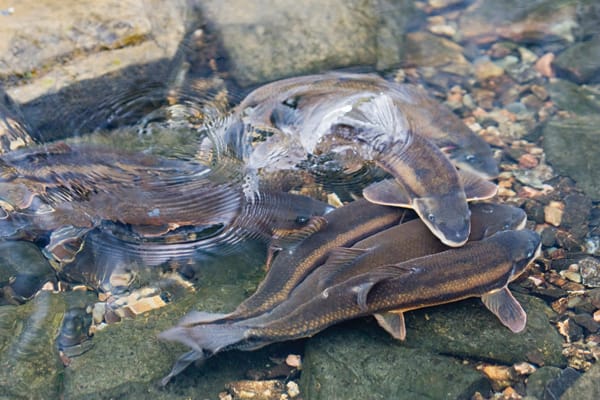When I was a boy, I spent every free minute outside. Nature was my TV, the seasons my calendar; time was marked by cycles of life. By that measure, nothing signaled the end of winter better than the much-anticipated sucker run.
Fish of 100 names
Not familiar with the white sucker (Catostomus commersoni)? Maybe you are, but with another name. Ever heard of the eastern, common, grey, black, mud, brook, June, coarse-scaled, fine-scaled, or slender sucker? How about the bay mare, truitu, mookie, muckie, or bay fish? This species goes by a different name nearly everywhere it’s found.
Confusion abounds when sucker species cross breed and spawn hybrids.
To top it off, it’s usually called mullet or black mullet at market—people tend to shy away from “sucker” at the fish counter.
Even as an angler (and something of a seafood connoisseur), I have never sampled Catostomus commersoni. Nevertheless, I’ve read that despite being a bit bony, the meat is soft and flaky, with a sweet taste that’s well suited to smoking, especially during the spawning run when commercial harvesters scoop them from rivers in parts of Canada.
Anglers who do pursue suckers use a small hook baited with worm, clam or little dough balls. Although less common, wet flies and small spinners can work too.

Every spring I was drawn to a little brook down the road from our home in a suburb of Halifax. The fish splashing about and crowding the stream were an irresistible attraction. Observation eventually lead to curiosity as my brothers, friends and I pondered the prospect of a capture. Like a great blue heron, I remember slowly edging closer, hovering motionless, hoping the fish would accept my presence. It was a test of patience, waiting for the right moment, for a big one to swim close. Then with a quick grab—splash, fish fleeing in all directions—I plunged my arms into the water and laid hands on a monster (by boyhood standards), wrestling the catch up the bank. Catches were followed by a live release, with the fish racing off downstream.
As I held those first fish, which glistened in the sun, I noticed the sucker’s most unique feature. Much like an aquarium algae eater, suckers have a mouth that faces downward with what can best be described as thick, fleshy lips. Several sucker species inhabit North America, but these were white suckers—the only variety native to Nova Scotia—and the best-known type, due to their vast distribution and relative abundance.
In fact, white suckers call much of North America home, from Labrador, across to the Rockies, north into the Territories, and down into the Southern US. Temperature extremes, low oxygen and pollution don’t deter these fish; they can thrive in virtually any freshwater habitat, from small streams to large lakes. Under ideal conditions, they grow up to 25 inches and seven pounds over a 15-year lifespan. Surprisingly, baby suckers—called fry—hatch with mouths shaped like conventional fish; they develop downward into the characteristic shape as they become juveniles.
Back to spring. Suckers create quite a spectacle with their splashing and thrashing during their spawning migration. In May or June, when the water reaches about 10ºC, they move en mass into spawning grounds for the annual renewing of the species. Normally peaceful creeks are transformed by a fury of vigorous splashing as suckers surge and pile atop one another, sometimes in water barely deep enough to cover their backs.
At times biologists have counted as many as 100 fish a minute passing upstream during five-minute intervals. Such commotion draws predators of every stripe to the water for an easy feast.
I am always amazed by the obstacles these fish overcome to reach their spawning grounds. In our brook I saw them surmount a beaver dam, three highway culverts, a dense swamp, very shallow water, and an 18-inch drop. With single-minded focus the fish negotiate tributaries in search of shallow-water gravel beds with moderate current, these being their preferred spawning grounds. Populations without access to suitable tributaries adapt and use shallow-water shoals, where waves generate currents over gravel.
One night I saw suckers spawning along the shore of a lake while eels, catfish, perch, and bass feasted on the eggs.
In either case, stream or shoal, the majority of spawning occurs overnight—particularly around dusk and dawn—and only runs into day during times of peak activity.
The spawning act itself is an intense yet casual affair. Typically two to four males crowd around a female, pressing her with their fins and bodies. The group jostle and bump for a while until they’re suddenly overcome by an explosion of excitement; tails spasm, water churns and splashes, then milt and eggs cloud the water.
Suckers are not known for their parenting ability. The fertilized eggs drift off on the current and adhere to solid surfaces downstream where they remain until hatching. After a brief rest the adults form up in new groups, and the process begins again—many times over. Females can produce 20,000 to 50,000 eggs per season, with large fish producing more than 100,000. Of these, only three per cent survive to the fry stage, and still fewer to adulthood.
Since my early encounters with the white sucker I’ve grown to become a reasonably experienced, conservation-oriented angler. Over the years, I’ve heard a few anglers describe suckers as nuisance fish; a worthless species that harms “more important” game fish by eating their eggs and competing for food. Biologists have discovered that the opposite is in fact true: suckers actually boost game fish populations by serving as an abundant food supply for them. Trout and salmon eat small suckers while bass, pickerel, muskie, walleye, and pike devour bigger ones, up to 12 inches.
Any sucker predation on game fish eggs, or food competition (and it surely does happen) is more than offset by the benefit that “desirable” species receive from feeding on a healthy sucker population. The suckers’ unique eating behavior—sifting through dirt, consuming food, then spitting out mud and sand—ensures that much of their food would have been inaccessible to other fish in any event.
I have no doubt that the time spent along the brook, witnessing nature bring forth new life, influenced my respect and wonder toward creation. Those were special days indeed, but alas, the distractions of adolescence eventually left the stream forgotten. Time passed, I grew up, moved away from the brook, went to college, got married, and began a career.
Fourteen years later I returned to the brook. Much had changed. Development was encroaching and the landscape was altered, but to my delight the suckers happened to be gathering for their annual show. As I watched I thought back to my carefree childhood days when many a lazy afternoon had been spent by the water’s edge.
The intrigue, wonder, and curiosity flooded back as if I had never missed a season. The realization then dawned: the cycle of life unfolds with or without an audience. I had been absent but the suckers had probably been back every year. Then I remembered that white suckers typically mature at five to eight years, so the fish I was seeing now were the grandchildren, possibly great grandchildren, of the fish I had known back then.
It was their turn now.
